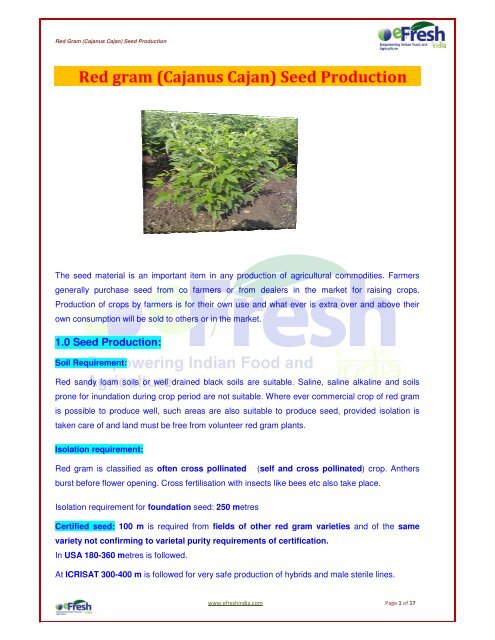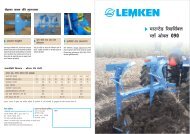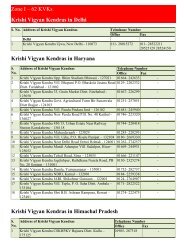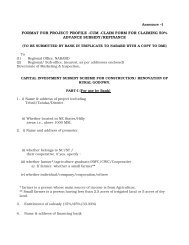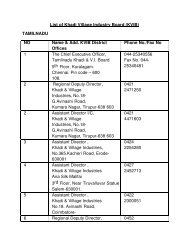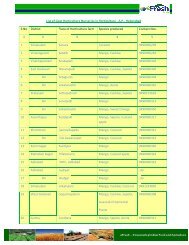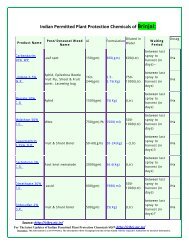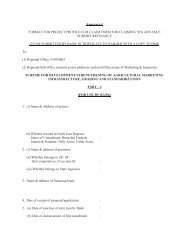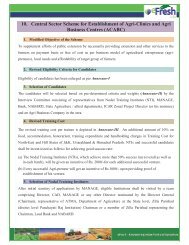Red gram (Cajanus Cajan) Seed Production - Efresh India
Red gram (Cajanus Cajan) Seed Production - Efresh India
Red gram (Cajanus Cajan) Seed Production - Efresh India
Create successful ePaper yourself
Turn your PDF publications into a flip-book with our unique Google optimized e-Paper software.
<strong>Red</strong> Gram (<strong><strong>Cajan</strong>us</strong> <strong>Cajan</strong>) <strong>Seed</strong> <strong>Production</strong><br />
<strong>Red</strong> <strong>gram</strong> (<strong><strong>Cajan</strong>us</strong> <strong>Cajan</strong>) <strong>Seed</strong> <strong>Production</strong><br />
The seed material is an important item in any production of agricultural commodities. Farmers<br />
generally purchase seed from co farmers or from dealers in the market for raising crops.<br />
<strong>Production</strong> of crops by farmers is for their own use and what ever is extra over and above their<br />
own consumption will be sold to others or in the market.<br />
1.0 <strong>Seed</strong> <strong>Production</strong>:<br />
Soil Requirement:<br />
<strong>Red</strong> sandy loam soils or well drained black soils are suitable. Saline, saline alkaline and soils<br />
prone for inundation during crop period are not suitable. Where ever commercial crop of red <strong>gram</strong><br />
is possible to produce well, such areas are also suitable to produce seed, provided isolation is<br />
taken care of and land must be free from volunteer red <strong>gram</strong> plants.<br />
Isolation requirement:<br />
<strong>Red</strong> <strong>gram</strong> is classified as often cross pollinated (self and cross pollinated) crop. Anthers<br />
burst before flower opening. Cross fertilisation with insects like bees etc also take place.<br />
Isolation requirement for foundation seed: 250 metres<br />
Certified seed: 100 m is required from fields of other red <strong>gram</strong> varieties and of the same<br />
variety not confirming to varietal purity requirements of certification.<br />
In USA 180-360 metres is followed.<br />
At ICRISAT 300-400 m is followed for very safe production of hybrids and male sterile lines.<br />
www.efreshindia.com Page 1 of 17
<strong>Red</strong> Gram (<strong><strong>Cajan</strong>us</strong> <strong>Cajan</strong>) <strong>Seed</strong> <strong>Production</strong><br />
Cultivation practices in brief:<br />
Land preparation:<br />
As red <strong>gram</strong> is a deep rooted crop, it requires at least one deep tilling up to 8 to 10 inches<br />
and one shallow tilling. Ploughing or preparation of field by bullock or tractor drawn cultivator<br />
(Gorru) followed by planking (Guntaka) to remove weeds is required before sowing.<br />
Sowing time / season:<br />
For higher yield ideal time for sowing in kharif is early in June. Sowings can be continued<br />
till August, but yield will be gradually reduced. During rabi, red <strong>gram</strong> can be sown from 15<br />
September till 15 October. In this also, September 15 sown crop give higher yield compared to<br />
October 15 sown crop. Pigeon pea produced during kharif will have better seed quality than<br />
summer.<br />
<strong>Seed</strong> source:<br />
Obtain higher grade seed (to produce certified seed, foundation seed is to be obtained) from<br />
source approved by the concerned state seed certification agency. If seed production is for private<br />
company then that company will supply seed.<br />
Pre-sowing treatment:<br />
Soak seed before sowing for 3 hrs in aqueous solution of SnSO4 100 ppm (1 g/10 litre water) at<br />
1/3 volume of seed and quickly air dry in shade to their original weight.<br />
<strong>Seed</strong> treatment:<br />
Treat seed with Pseudomonas fluorescence @ 10 g/kg seed. Bio control agents are compatible<br />
with bio fertilizers. First treat seed with bio control agents and then with Rhizobium.<br />
Treat with Rhizobial culture CC1. For red lateritic soil Rhizobial culture VPR 1 is effective.<br />
One packet of 200 g Rhizobial culture is sufficient for treating seed required for one acre.<br />
During rabi 200 g culture/8 kg seed is needed. The bacterial culture slurry may be<br />
prepared with rice gruel (ganji) or jaggery solution. Dry bacterial culture treated seed in<br />
shade for 15 minutes before sowing.<br />
www.efreshindia.com Page 2 of 17
<strong>Red</strong> Gram (<strong><strong>Cajan</strong>us</strong> <strong>Cajan</strong>) <strong>Seed</strong> <strong>Production</strong><br />
Method of sowing:<br />
Sowing is done at a depth about 5 cm, either with seed cum fertiliser drill or dropped in plough<br />
furrow.<br />
Spacing & <strong>Seed</strong> rate:<br />
Spacing & <strong>Seed</strong> rate for different situations are given here.<br />
Situation Spacing, cm <strong>Seed</strong> rate, kg/Ac<br />
Kharif black soils 150 x 20 or 180 x 20 3-4<br />
kharif light/red soils 90 x 20 6-7<br />
rabi irrigated 75-90 x 10 10-12<br />
rabi rain fed 45-60 x 10 12-15<br />
Manuring & Fertilisation:<br />
Application of 2.0 tonnes of well decomposed FYM/compost/Ac or 0.8 to 1.2 tonnes of vermi<br />
compost mixed with 2 kg PSB (phosphate solubulizing bacteria)/Ac is needed during last tilling<br />
Addition of 5-10 quintal neem leaf manure is beneficial not only in terms of increased nutrient<br />
supply, but also in terms of reduced problem of soil borne pathogens and nematodes<br />
In kharif apply 8 kg N + 20 kg P 2 0 5 (50 kg DAP or 20 kg urea + 125 kg SSP)/Ac as basal<br />
application and incorporated before sowing seed. Otherwise use seed cum fertiliser drill at sowing.<br />
In rabi apply 16 kg N + 20 kg P 2 0 5 (50 kg DAP + 15 kg urea) or (35 kg urea + 125 kg SSP)/Ac as<br />
basal application and incorporated before sowing seed. Otherwise use seed cum fertiliser drill at<br />
sowing.<br />
Apply 200 litres of Sanjeevak or Jeevamrut/Ac at the time of sowing or immediately after, for ready<br />
availability of micro-organisms to improve soil fertility.<br />
Spraying 10 to 15 g urea/litre of water at initial reproductive stage of crop is beneficial for<br />
increasing yield in rain fed drought conditions. At any time concentration should not exceed 20<br />
g/litre of water<br />
Application of phosphate solubulizing bacteria (PSB) for release of fixed P 2 0 5 in the soil is an<br />
effective bio fertilizer.<br />
www.efreshindia.com Page 3 of 17
<strong>Red</strong> Gram (<strong><strong>Cajan</strong>us</strong> <strong>Cajan</strong>) <strong>Seed</strong> <strong>Production</strong><br />
Irrigation:<br />
Photo 1 - Good Growth of <strong>Red</strong> Gram<br />
As red <strong>gram</strong> is mainly a rain fed crop, usually irrigations are not being given. However, in seed<br />
production, irrigating when moisture deficit occurs, will improve yield and profits greatly.<br />
Irrigation during dry spells in kharif and moisture deficit periods during rabi are essential to obtain<br />
good yields.<br />
If there is moisture deficit, irrigation before bud formation and during pod formation stage<br />
improves yield.<br />
www.efreshindia.com Page 4 of 17
<strong>Red</strong> Gram (<strong><strong>Cajan</strong>us</strong> <strong>Cajan</strong>) <strong>Seed</strong> <strong>Production</strong><br />
Weed Management & Inter-culture:<br />
Weed management is required up to 60 days of crop growth, as this is the time when weeds<br />
compete with the crop for nutrients. Interculture operations should be done to keep the field weed<br />
free and to preserve soil moisture and to improve microbial activity. One or two hand weedings or<br />
hoeings are to be done at about 30 and 60 days after sowing depending on weed growth.<br />
Spraying of chemical weedicides like Pendimethalin 30% @ 1 to 1.5 litres/Ac or Alachlor @ 1<br />
litre/Ac immediately after sowing or within 24 hrs after sowing is recommended. Normally no<br />
weeding is required after 60 days of crop growth. If it is needed, manual weeding can be done.<br />
Important pests and diseases:<br />
Gram pod borer (Helicoverpa armigera) is a major pest on red <strong>gram</strong>. It damages flower buds<br />
and pods. It keeps half of its body outside while feeding on pods. Deep ploughing is an effective<br />
measure for its control besides other IPM measures.<br />
To attract spiders and ants that predate on larvae of insects mix 4 kg Jaggery powder with 200<br />
litres water and sprayed on one Ac soil surface,<br />
About 20 bird perches per Ac are to be installed to attract birds that predate on pests. Yellow rice<br />
(1 kg rice cooked with turmeric powder) can be kept on or near perches to attract predatory birds.<br />
Release of 5000 eggs of Chrysoperla 15 days after sowing and 50,000 eggs of Tricho<strong>gram</strong>ma (2-<br />
3 cards) 30 days after sowing can keep pest problem below ETL (1 to 2 caterpillars/m 2 or 5 to<br />
10% pod damaged). Four pheromone traps/Ac can be used for pest monitoring.<br />
Control measures:<br />
If the pest exceeds ETL, following control measures can be adopted:<br />
1. Immediately after observing eggs or early instar larvae spray 5% NSKE (50 g crushed<br />
neem seed in 50 litre water) or 5 ml/litre neem oil (azadirachtin) in initial stages for ovicidal<br />
action to kill eggs of Helicoverpa.<br />
2. Biological control methods like spraying 200 LE of NPV or 400 g Bt or fungal parasite<br />
Beauveria bassiana/Ac should be done to control Helicoverpa pest and also to reduce<br />
poisonous pesticide usage which pollute environment.<br />
3. Bigger larvae can be hand picked and destroyed.<br />
www.efreshindia.com Page 5 of 17
<strong>Red</strong> Gram (<strong><strong>Cajan</strong>us</strong> <strong>Cajan</strong>) <strong>Seed</strong> <strong>Production</strong><br />
If it is not possible to control the pest, take up chemical sprayings as detailed below:<br />
Spray @ 2.0 ml quinalphos 25 EC or 1 g Acephate/litre water. 200 litre spray fluid/Ac is required.<br />
Total 2-3 sprays during flowering and pod formation stages, at 10 day interval are required.<br />
Change chemical each time.<br />
For immediate control spray @ 1 ml indoxacarb or 0.3 ml spinosad 45 sc/litre water. 200<br />
litre spray fluid/Ac is required.<br />
Maruca:<br />
This pest attacks at bud formation, flowering and pod formation stages. For control, spray @ per<br />
litre water. Spray at an interval of 1 week. Every time change chemical shown on left side of the<br />
table. 200 litre spray fluid/Ac is required.<br />
2.5 ml chlorpyriphos or<br />
0.75 ml novoluron or<br />
0.75 ml spinosad or<br />
1 ml lambda cyhalothrin<br />
+ 1 ml dichlorvos<br />
Wild Boars:<br />
Controlling them by erecting solar fence around the plot is effective. <strong>Seed</strong> production plots must<br />
be well protected as the value of produce is more. Commitments will also be there to produce<br />
seed compulsorily.<br />
Diseases:<br />
Fusarium wilt is an important disease that can also be a serious problem in some places.<br />
<strong>Seed</strong> treatment with 8 g Trichoderma viridae/kg seed is essential for prevention of wilt.<br />
Sterility Mosaic:<br />
This virus disease spreads through eriophid mite. Preventing spread of this disease through<br />
control of eriophid mite is essential. Two chemical fungicidal sprays with 3 g wettable sulphur or 4<br />
ml kelthane/litre of water alternatively at an interval of one week can be done for control of mites.<br />
www.efreshindia.com Page 6 of 17
<strong>Red</strong> Gram (<strong><strong>Cajan</strong>us</strong> <strong>Cajan</strong>) <strong>Seed</strong> <strong>Production</strong><br />
Macrophomina wilt:<br />
Drying of total plant or few branches will be observed. Take up seed production of only tolerant<br />
varieties like Surya (MRG 1004) and MRG 66. It is better to avoid seed production of susceptible<br />
varieties in endemic plots for such diseases.<br />
In seed production effective and quick control of pests and diseases is essential.<br />
Roguing:<br />
Rogue off types and diseased plants affected by Fusarium and Macrophomina wilt, sterility mosaic<br />
virus in seed field from time to time.<br />
Minimum number of 2 field inspections will be done by certification agency during flowering to<br />
harvest.<br />
<strong>Red</strong> <strong>gram</strong> crop at flowering stage<br />
<strong>Red</strong> <strong>gram</strong> flower<br />
www.efreshindia.com Page 7 of 17
<strong>Red</strong> Gram (<strong><strong>Cajan</strong>us</strong> <strong>Cajan</strong>) <strong>Seed</strong> <strong>Production</strong><br />
Different varieties of <strong>Red</strong> <strong>gram</strong> at pod stage<br />
Harvesting, threshing & cleaning:<br />
www.efreshindia.com Page 8 of 17
<strong>Red</strong> Gram (<strong><strong>Cajan</strong>us</strong> <strong>Cajan</strong>) <strong>Seed</strong> <strong>Production</strong><br />
Harvested crop is left in the field to dry for about a week so that drying of pods to about 12<br />
to 13% moisture content takes place. Later, threshing is to be done by threshers or manually.<br />
Then seed is cleaned and dried to 8-9% moisture. Use only highly germinable (90% and above)<br />
and normal coloured seed retained in wire mesh sieve, BSS 5 x 5 (aperture width 3.35 mm) for<br />
large seeded varieties and BSS 6 x 6 (2.8 mm) for small seeded varieties for storing. Reject those<br />
seed that pass through the sieve as well as discoloured and broken seed.<br />
Yield:<br />
Yield varies from 8-10 q/Ac.<br />
Storing:<br />
Graded seed should be further dried to 7 to 8% moisture.<br />
For storing seed in dry places up to six months, they should be packed in fresh thick cloth<br />
or gunny bags.<br />
For storing in humid areas and for long term (1-2 years) storage; they should be packed in<br />
moisture-vapour-proof container like polythene bags of 700 gauge.<br />
These bags should be filled with seed leaving only sufficient space to close their opening<br />
by perfectly heat-sealing to make it air tight.<br />
They should be stitched and closed.<br />
These bags may in turn be covered by gunny bags and closed before stocking to prevent<br />
slipping.<br />
Store seed bags on racks or wooden pallets in a dry storage room.<br />
Another method treating seed with halogen mixture (containing pure CaOC1, CaCO3 and<br />
arappu leaf powder in 5:5:1 ratio @ 3g/kg) and store in 700 gauge poly bags to maintain<br />
high germination for more than 10 months.<br />
Care must be taken to prevent mechanical admixture during sowing, harvesting,<br />
threshing, winnowing, drying, bagging, storing etc.<br />
End of Chapter 1.0<br />
www.efreshindia.com Page 9 of 17
<strong>Red</strong> Gram (<strong><strong>Cajan</strong>us</strong> <strong>Cajan</strong>) <strong>Seed</strong> <strong>Production</strong><br />
2.0 While purchasing seed from Co-Farmers one has to observe:<br />
Whether the seed crop is thoroughly rouged or not.<br />
What is the yielding capacity of the variety?<br />
Whether the variety is free from pests and diseases etc.<br />
If the farmer is fully satisfied then only that seed has to be procured.<br />
End of Chapter 2.0<br />
3.0 Precaution to be taken while purchasing seed from the market:<br />
Purchase seed from reliable source only<br />
Purchase from authorized /licensed dealer.<br />
Take receipt.<br />
Check MRP (Maximum Retail Price) before purchase. It should not exceed.<br />
Check whether the seal of bag or container is intact or not<br />
If seal is broken don’t purchase, select another good one.<br />
Check germination percentage before sowing at the house/farm. It can be easily done.<br />
Count 100 seeds. Sow these seeds @ 10/line in 10 lines.<br />
Give light watering regularly every day till germination takes place in about a week’s time.<br />
Observe number of seedlings germinated , so that the germination percentage is known in<br />
advance of sowing<br />
If the germination percentage is less than 80% the extra seed has to be sown to<br />
compensate loss in germination percentage<br />
Preserve the bill, bag and Tag till the end of the season i.e., harvest of the crop.<br />
If there is poor germination it has to be reported to the local agriculture officer concerned in<br />
writing. The Director of Research of Agricultural University will nominate a scientist to visit the<br />
field along with Agricultural Departmental Officials, to check seed plots and ascertain whether<br />
there are defects in seed or not. If the seed is defective farmer has to file a case against the seed<br />
company in the consumer forum to get compensation.<br />
If defects are noticed in the middle of the season like no flowering in the crop; admixtures in the<br />
variety; even then farmer has to report to the local agricultural officer in writing about the defects<br />
in the variety supplied. He has to produce proof of purchase namely bill, bag or container. The<br />
www.efreshindia.com Page 10 of 17
<strong>Red</strong> Gram (<strong><strong>Cajan</strong>us</strong> <strong>Cajan</strong>) <strong>Seed</strong> <strong>Production</strong><br />
team will give a report. Based on the report if the defect in the variety is confirmed farmer<br />
can go to consumer forum to get compensation.<br />
Where ever farmers produce seed on large scale it has to be sold to others.<br />
<strong>Production</strong> of red <strong>gram</strong> seed by farmers is mainly of two types: <strong>Seed</strong> production with out<br />
certification (for self consumption and local selling) and with certification (for selling in far away<br />
places to production centres i.e. for growing over a wide area.<br />
Uncertified seed is mainly meant for growing in nearby or local area. It may be in the same<br />
village or surrounding villages, or where popularity exists for such uncertified seed based on faith.<br />
End of Chapter 3.0<br />
4.0 Uncertified seed:<br />
Uncertified seed is mainly meant for growing in nearby or local area.<br />
It may be in the same village or surrounding villages, or where popularity exists for such<br />
uncertified seed based on faith.<br />
Procurement of seed required for seed production can be from farmers own seed or<br />
procured from public or private organisations.<br />
Identify vigorously growing healthy plants, free from insect pests and diseases.<br />
Harvest seed from them and use for producing seed.<br />
Following Isolation requirement, periodical rouging before/during flowering and during pod<br />
development helps in improving quality and also market value of seed produced from it<br />
compared to not following all these practices.<br />
All cultivation practices are similar to certified seed. But there is neither registration with<br />
certifying agency nor buy back agreement with any private organisation.<br />
<strong>Seed</strong> produced in this manner will be sold to persons having faith on the producer.<br />
To such seed producers it is advised to procure foundation seed from organisations like<br />
Agricultural University/ICAR research stations for producing certified seed.<br />
Clean cultivation along with timely rouging and harvesting is to be done.<br />
Threshing and cleaning can be taken up by individually.<br />
Processing packing marketing etc can be done individually or through farmer’s societies.<br />
Registration with seed cortication agency of the state concerned like Andhra Pradesh<br />
State <strong>Seed</strong> Certification Agency (APSSCA) for AP can be done individually or as a group<br />
in a contiguous area.<br />
Thus farmers can get 20-50% more income in seed production compared to commercial<br />
cultivation of red <strong>gram</strong>.<br />
www.efreshindia.com Page 11 of 17
<strong>Red</strong> Gram (<strong><strong>Cajan</strong>us</strong> <strong>Cajan</strong>) <strong>Seed</strong> <strong>Production</strong><br />
Certified seed is mainly meant for growing over a wide area even throughout globe. Certified seed<br />
production details are given here.<br />
End of Chapter 4.0<br />
.<br />
5.0<br />
Do’s:<br />
1. <strong>Red</strong> <strong>gram</strong> cultivation should be done only in well drained black cotton soils or red<br />
sandy loam soils. Take up deep summer ploughing up to 8 inches depth. It destroys<br />
and reduces <strong>gram</strong> caterpillar (<strong>Red</strong> <strong>gram</strong> pod borer Helicoverpa armigera) pupae<br />
hibernating in soil.<br />
2. Use quality higher grade seed to produce quality lower grade seed.<br />
3. Use optimum seed rate and sow in time.<br />
4. Follow effective control measures in pest and disease control.<br />
5. Avoid moisture stress before flowering and seed development stage.<br />
6. Take up soil and moisture conservation measures for rain fed crop.<br />
7. Foliar spray @ 10-15 g urea/litre water at the initial reproductive stage is beneficial<br />
for increasing yield in rain fed drought condition.<br />
Don’ts:<br />
1. Don’t take up red <strong>gram</strong> (RG) seed production in saline soils as they are not suitable<br />
for its cultivation.<br />
2. Don’t cultivate RG crop in soils with poor drainage.<br />
3. Don’t sow RG crop after 15 th Aug in any case. Avoid late sowing.<br />
4. Don’t mix bio agents like Trichoderma viridae or Rhizobium with chemical<br />
pesticides<br />
5. Don’t take up topping.<br />
End of Chapter 5.0<br />
www.efreshindia.com Page 12 of 17
<strong>Red</strong> Gram (<strong><strong>Cajan</strong>us</strong> <strong>Cajan</strong>) <strong>Seed</strong> <strong>Production</strong><br />
6.0 <strong>Seed</strong> certification procedures are given in annexure<br />
ANNXURE<br />
<strong>Seed</strong> Certification Procedures<br />
Phases of <strong>Seed</strong> Certification<br />
Certification shall be completed in six broad phases listed under<br />
• Receipt and scrutiny of application.<br />
• Verification of seed source, class and other requirements of the seed used for raising the seed<br />
crop.<br />
• Field inspections to verify conformity of the standing crop to the prescribed field standards.<br />
Supervision at post harvest stages including processing and packing.<br />
• Supervision of post-harvest stages including processing and packaging;<br />
• <strong>Seed</strong> sampling and analysis, including genetic purity test and / or seed health test, if any, in<br />
order to verify conformity to the prescribed standards and<br />
• Grant of certificate and certification tags, bagging and sealing.<br />
<strong>Seed</strong> Certification Procedures<br />
All the seed material to be used for seed production pro<strong>gram</strong>me is subject to verification by the<br />
Agency. The seed producer should submit to the Agency relevant evidence such as certification<br />
tags, seals, labels, seed containers, purchase records, sales records etc, as may be demanded by<br />
the Agency during scrutiny of the application and/or during the first inspection of the seed crop in<br />
order to confirm that the seed used for raising the crop has been obtained from a source approved<br />
by the Agency and conforms to the class of seed required for seed production. A sourceverification<br />
register containing relevant information as prescribed should be maintained by the<br />
seed producer for verification by Agency staff.<br />
After source verification application for certification should be submitted in the prescribed FORM-1<br />
in triplicate to the concerned Assistant Director of <strong>Seed</strong> Certification. FORM-1 is available with the<br />
divisional and zonal offices of the Agency._ FORM-1 should be submitted within 30 days from the<br />
date of sowing or 15 days from the date of transplanting as the case may be.<br />
www.efreshindia.com Page 13 of 17
<strong>Red</strong> Gram (<strong><strong>Cajan</strong>us</strong> <strong>Cajan</strong>) <strong>Seed</strong> <strong>Production</strong><br />
The relevant seed certification charges such as Registration fee, inspection fee grow out test<br />
charges (wherever necessary), seed testing charges, etc. should be remitted along with FORM-1,<br />
Separate FORM-1 should be submitted for certification of each variety. The FORM-1 should<br />
contain complete details of the name and address of the seed producer; season of production;<br />
name and address of the grower; location of the seed plot; crop/ variety and class of seed to be<br />
produced; area under seed production; details of parental seed materials used with lot number;<br />
date of sowing and the particulars of seed certification charges remitted.<br />
• In a single application, the maximum area that can be offered for certification is 25 acres.<br />
Additional area will require separate application.<br />
• No refund of inspection and registration fee will be made once the seed plot has been visited /<br />
inspected by the <strong>Seed</strong> Certification Officer.<br />
• The seed producer should assist the Agency staff in locating the seed plots during the first<br />
inspection.<br />
• <strong>Seed</strong> producers should guide their growers in agronomic practices, pest/disease control etc., for<br />
seed production.<br />
• Only seed from plots meeting all the prescribed field standards for certification is accepted for<br />
processing at the recognised seed processing plants.<br />
• All the necessary care should be taken to avoid admixture during harvesting, threshing and<br />
transportation.<br />
• Harvested seed produce from the approved fields should be brought to the seed processing unit<br />
and seeds are certified within 2 ½ months from the date of harvest.<br />
• Certification of a seed lot will be taken up only if the seed lots have met the prescribed field and<br />
seed standards.<br />
FIELD INSPECTION:<br />
Inspection of the standing crop is an essential step in verifying conformity of seed crop to<br />
prescribed minimum seed-certification standards. All the registered seed production fields will be<br />
inspected by qualified, trained and experienced officers of the Agency.<br />
Verification of all factors affecting seed quality in the field may not normally be possible in a single<br />
inspection as all the factors in the field may not be apparent or may not occur at the same time or<br />
all of them may not affect seed quality at the same stage of crop growth. Hence two or more<br />
inspections phased to cover all the important stages of crop growth are required for most crops.<br />
The number of inspections and the stages of crop growth at which they should be conducted vary<br />
www.efreshindia.com Page 14 of 17
<strong>Red</strong> Gram (<strong><strong>Cajan</strong>us</strong> <strong>Cajan</strong>) <strong>Seed</strong> <strong>Production</strong><br />
from crop to crop depending on the crop duration, pollination behavior, susceptibility to<br />
contamination, disease-susceptible stages, nature of the contaminating factors, etc.<br />
Accordingly field inspection of seed certification plots is conducted at vegetative or pre-flowering<br />
stage; flowering stage, post-flowering and pre-harvest stage.<br />
Field Inspections at vegetative or pre flowering stages are done to confirm the actual acreage<br />
planted and compare it with the acreage allotted or for which the application was submitted and to<br />
record the excess area if any and to confirm actual date of sowing/planting verify, for seed crops<br />
involving two different parents, whether the grower has followed the recommended planting ratios<br />
and border rows and has marked" the end of each male row: verify the presence of any<br />
contaminant within the prescribed isolation distance, guide the grower in solving the isolation if<br />
any and advise the grower to remove the same before flowering.<br />
* advise the removal of all off types on the basis of vegetative characters.<br />
* detect occurrence of any contamination within the isolation distance and to determine the area to<br />
be rejected due to inadequate isolation.<br />
* guide the grower in solving nicking problems wherever applicable.<br />
* verify morphological characters of the crop.<br />
* Inspection at post-flowering and pre harvest stages is done to confirm that the observations on<br />
planting ratios, planting of border rows, off types, de tasseling of maize crosses, removal of pollen<br />
shedders in bajra, sorghum, sunflower etc. during previous inspections are reasonably accurate<br />
and the defects in these factors had not escaped attention in earlier inspections.<br />
* Confirm that the grower had done through roguing after the inspection at flowering.<br />
verify the removal of contaminating factors, objectionable weed plants and diseased plants/heads.<br />
* educate the grower about harvesting technology, give guidance regarding the care to be taken<br />
during harvesting, threshing and transportation, and assess the expected yield (approximate) from<br />
the seed crop.<br />
www.efreshindia.com Page 15 of 17
<strong>Red</strong> Gram (<strong><strong>Cajan</strong>us</strong> <strong>Cajan</strong>) <strong>Seed</strong> <strong>Production</strong><br />
PRESCRIBED FIELD STANDARDS FOR RED GRAM UNDER CERTIFICATION:<br />
Maximum permissible level off types in Foundation seed 0.10 % Certified seed 0.20 %<br />
FIELD COUNTS:<br />
For all crops five counts are taken for an area up to 5 acres, and an additional count taken<br />
for each additional five acres as given below.<br />
Area of the field crop, Acres No. of counts to be<br />
taken<br />
0-5 5<br />
5-10 6<br />
10-15 7<br />
15-20 8<br />
20-25 9<br />
In any inspection if the first set of counts shows that the seed crop does not confirm to the<br />
prescribed standards for any factor, 'a second set of counts should be taken for that factor.<br />
However, when the first set of counts shows a factor is more than twice the maximum permitted it<br />
is not necessary to take a second set of counts. Two sets of counts are called double counts.<br />
Some cops tiller others do not, some are planted narrow. Others wide, thus the number of<br />
plants/heads comprising a single count differs from crop to crop. No. of plants/head per count in<br />
red <strong>gram</strong> is 100.<br />
<strong>Seed</strong> crops meeting the prescribed field standards for certification will be harvested, threshed and<br />
transported to seed processing plants authorised by STATE SEED CERTIFICATION AGENCY<br />
along with Final Filed Inspection Report issued by the concerned <strong>Seed</strong> Certification Officer.<br />
REJECTION OF SEED PLOTS:<br />
The agency has the authority to reject seed plots offered for certification on the following grounds.<br />
The isolation distance is inadequate. The seed crop does not conform to the prescribed field<br />
standards for any factor or contaminant. One-third or more of a self-pollinated crop is so heavily<br />
lodged as to render it impossible to take the field counts. One-third or more is lodged just prior to<br />
or during flowering so that inspection during flowering is difficult / not possible. The application in<br />
www.efreshindia.com Page 16 of 17
<strong>Red</strong> Gram (<strong><strong>Cajan</strong>us</strong> <strong>Cajan</strong>) <strong>Seed</strong> <strong>Production</strong><br />
Form-1 has been submitted late viz., when the crop has crossed the flowering stage by the time of<br />
the first inspection.<br />
RE-INSPECTION:<br />
In case of seed fields rejected due to nonconformity to the prescribed field standards at a certain<br />
inspection, the Agency shall, at the producer's request and after removal of source of<br />
contamination or contaminant plants in the seed field by the grower, undertake one re-inspection<br />
over and above the number of inspections prescribed for the crop provided the removal of the<br />
source of contamination can ensure conformity of the seed crop to the standards prescribed and<br />
provided further that no irreversible damage has been caused to the quality of the seed by the<br />
contaminant(s)<br />
HARVESTING, THRESHING AND TRANSPORTATION:<br />
A seed crop meeting the field standards for certification shall be properly harvested, threshed,<br />
dried and transported to the registered seed processing unit and certified within 2+ months from<br />
the date of harvest. During these operations seed producers/growers should take all necessary<br />
precautions to safeguard seed quality by preventing seed admixture and other causes of<br />
contamination at any stage not supervised by the Agency.<br />
SPOT SORTING, SHELLING AND CERTIFICATION OF SEED PRODUCE:<br />
For crops like maize, potato and groundnut, on the request of the seed producer, permission shall<br />
be granted to take up certification work at the field level, provided the seed processing unit is<br />
located far away from the seed field, transportation of the bulk seed produce may not be<br />
economical and there is lack of adequate 'storage space at the seed processing unit or any other'<br />
reasons to the satisfaction of the divisional head of seed certification.<br />
Work in .respect of the above crops shall be taken up in presence of the representative of the<br />
<strong>Seed</strong> Certification Agency and upon remitting the prescribed fees.<br />
End of Chapter 6.0<br />
www.efreshindia.com Page 17 of 17


